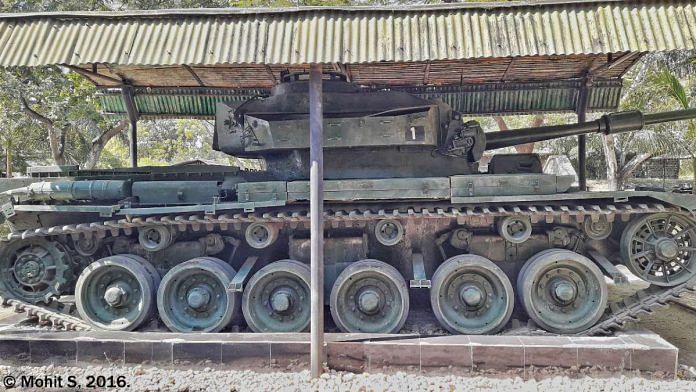New Delhi: Weapons and equipment used in the 1965 and 1971 India-Pakistan wars will be paraded down the Rajpath this Republic Day Parade, as part of the ‘Azadi ka Amrit Mahotsav’ celebratations of 75 years of independence.
This year, on 26 January, these armoured vehicles and artillery pieces will symbolise the battles fought by the Indian armed forces over the past decades.
On show will be one of the most prominent mechanised equipment of those bygone conflicts — the iconic Centurion, the British-origin main battle tank of the Indian Army in the 1965 and 1971 wars.
ThePrint explains the historical significance of some of these pieces.
Also read: The 1971 Battle of Longewala: A night of confusion, Sam Manekshaw’s order, Pakistan’s folly
Hero of the battle of Basantar & other significant pieces
Weighing around 50 tonnes and armed with a 17-pounder main gun, the Centurion accommodated a four-man crew. In the 1971 India-Pakistan war, the tank played a crucial role in the Battle of Basantar (4-11 December 1971) in the western sector, and performed admirably in operations, including establishing bridgeheads, in the eastern sector.
The OT-62 TOPAS, made by the Polish People’s Republic and Czechoslovakia, will also be part of the parade. This was a series of amphibious and tracked armoured personnel carriers (APCs), which also played an integral role in the Battle of Basantar in 1971.
Soviet-era tank PT-76, which did the heavy lifting for the Indian armoured divisions in the 1971 war, mostly in the eastern sector, will be showcased too. It weighs 14.6 tonnes and its amphibious capabilities made it a winner in the riverine terrain of what was then East Pakistan, now Bangladesh.
The PT-76’s 76.2-mm rifled bore gun was instrumental in neutralising Pakistan’s US-origin M24 light Chafee tanks. Moreover, these tanks spread panic among Pakistani ranks in the pitched battles of Boyra, Hilli and Rangpur (now in Bangladesh).
India’s first indigenously made artillery piece, the 75/24 Towed Gun, which was introduced in the 1960s to replace the 3.7 inch British-made gun, will also take part in the parade. The 75/24 Pack Howitzer Mk-1 weighs 983 kg, has a maximum range of up to 11,104 metres and can easily be airlifted or disassembled into smaller parts for easy transportation.
Thrown into the intense battles of the 1965 and 1971 wars, the Mk-1 performed brilliantly with its accurate firepower. It was replaced in the 1980s by the 105mm Indian Field Gun (IFG), another howitzer of indigenous design and development.
The Tiger Cat missile system will also roll doll the Rajpath on 26 January. This was a land-based mobile system version of the British Sea Cat point-defence missile system and weighed 68 kg. Introduced in the Army in 1972 as part of its air defence artillery, this missile had an operating range of 500 to 5,000 metres, and was 1.48 metres in length and 0.22 metres in diameter.
(Edited by Saikat Niyogi)
Also read: The war Pakistan lost and India didn’t win



